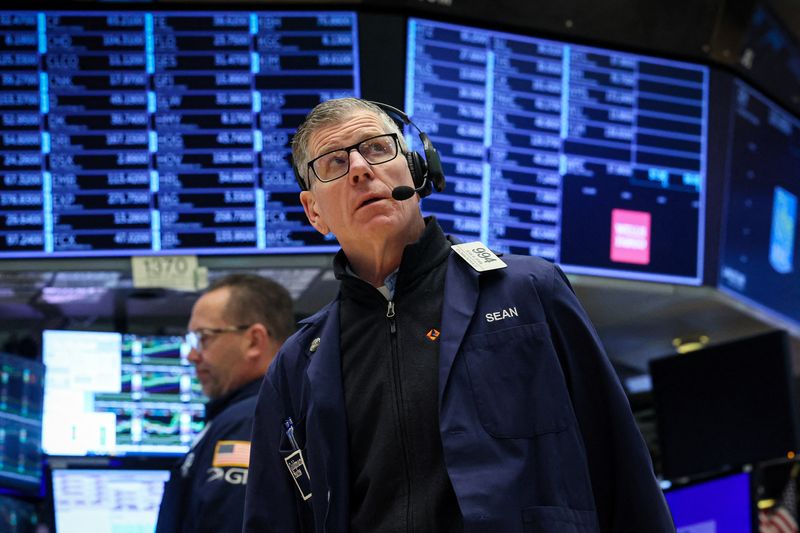
Nvidia (NASDAQ:NVDA) beat expectations with its quarterly earnings, but underwhelming guidance from the artificial intelligence darling resulted in a sharp selloff after hours.
Nvidia reported adjusted earnings of $0.68 a share on revenue of $30.04 billion, beating estimates of $0.64 and $28.68 billion, for the three months ended July 28, as well as announcing a $50 billion stock buyback program.
The stronger quarterly results were supported by a 154% surge in data center revenue to $26.27 billion from the same period a year earlier.
However, the stock dropped almost 7% in after hours trading, losing $200 billion in market value after its revenue guidance for the current quarter – of around $32.5 billion – missed some estimates, as did its gross margin outlook. The forecasts also presented a slowing pace of growth from prior quarters.
Nvidia also confirmed that it was facing some difficulties with its Blackwell line of advanced AI chips, although they were still set for launch by the fourth quarter.
Surging demand for its AI chips have helped Nvidia crush consensus analyst estimates for several quarters, resulting in its market capitalization soaring above $3 trillion, briefly becoming the world’s most valuable company in June.
Nvidia shares have rallied more than 150% this year thanks to insatiable demand for generative artificial intelligence, and this hefty drop in its shares could turn out to be just another dip to buy this much-admired company.
U.S. stock futures traded in a mixed fashion Thursday, with the tech-heavy Nasdaq underperforming after chipmaking giant Nvidia’s results failed to live up to lofty expectations.
By 04:05 ET (08:05 GMT), the Dow futures contract was 155 points, or 0.4%, higher, S&P 500 futures traded largely flat, while Nasdaq 100 futures fell by 30 points, or 0.2%.
Nvidia’s shares dropped around 7% premarket after the AI darling failed to impress investors despite exceeding expectations on the top and bottom lines [see above].
With the Nvidia watch party now over, attention will turn back to the strength of the U.S. economy and the likely impact on the Federal Reserve’s monetary policy.
Weekly initial jobless claims, pending home sales and the latest iteration of second-quarter growth data are due later in the session, ahead of the widely-watched July personal consumption expenditures price index on Friday.
Investors will also have the chance to study quarterly results from the likes of some notable consumer names, including Dollar General (NYSE:DG), Ulta Beauty (NASDAQ:ULTA), Lululemon Athletica (NASDAQ:LULU) and Best Buy (NYSE:BBY).
Elsewhere, Salesforce (NYSE:CRM) and CrowdStrike (NASDAQ:CRWD) will be in the spotlight after both companies released their results after the close Wednesday.
Apple (NASDAQ:AAPL) was seen ordering components for a much higher number of iPhones than last year, suggesting the technology giant is preparing for an artificial intelligence-driven boost to sales.
Apple ordered components and parts for between 88 million to 90 million of its flagship device, Nikkei reported, compared to initial component orders of about 80 million iPhones.
The firm is set to unveil the latest iteration of its flagship iPhone in early-September, the iPhone 16, and will also start rolling out a slew of artificial intelligence features in its devices.
The increased orders reflect a slew of analyst forecasts that AI will help power a new round of growth in iPhone sales, which have been steadily declining over the past year.
Kamala Harris, and her running mate Tim Walz, will sit for an interview with CNN later Thursday, in what will be her first interview since becoming the Democratic candidate in late July after President Joe Biden ended his campaign for re-election.
While Harris has occasionally taken questions from journalists on foreign and economic policies on the campaign trail, she has yet to do a one-on-one media interview or hold a formal press conference.
Harris laid out some broad policy agendas at the Democratic National Convention last week, promising a middle class tax cut at home and a muscular foreign policy of standing up to Russia and North Korea, but this interview could offer her the opportunity to put flesh to these bones..
U.S. Republican candidate Donald Trump and his Democratic rival Kamala Harris are also set to hold a presidential debate next month – the first chance some 240 million U.S. voters will get to hear Trump and Harris explain their policies side by side ahead of the Nov. 5 election.
Crude prices steadied Thursday after two losing sessions, as traders digested the prospect of extended supply disruptions.
By 04:05 ET, the U.S. crude futures (WTI) traded flat at $74.52 a barrel, while the Brent contract fell 0.1% to $77.52 a barrel.
Crude markets were nursing two straight days of losses, reversing a recent rebound amid persistent concerns that slowing growth in the U.S. and China will dent demand in the coming months.
Production disruptions in Libya, a member of the Organization of the Petroleum Exporting Countries, kept traders attaching some risk premium to crude, as did signs of a sustained conflict in the Middle East.
Additionally, Ukraine’s military said on Thursday it had attacked two oil storage facilities in Russia – the Atlas (NYSE:ATCO) oil depot in the southern Rostov region as well as the Zenit oil facility in Russia’s Kirov region.
These supply concerns overshadowed the news that U.S. oil inventories fell by less than expected in the week to August 23, with the Energy Information Administration reporting a drop of 0.85 million barrels.
This ramped up concerns that U.S. oil demand will cool as the travel-heavy summer season comes to a close.
To read the full article, Click Here
